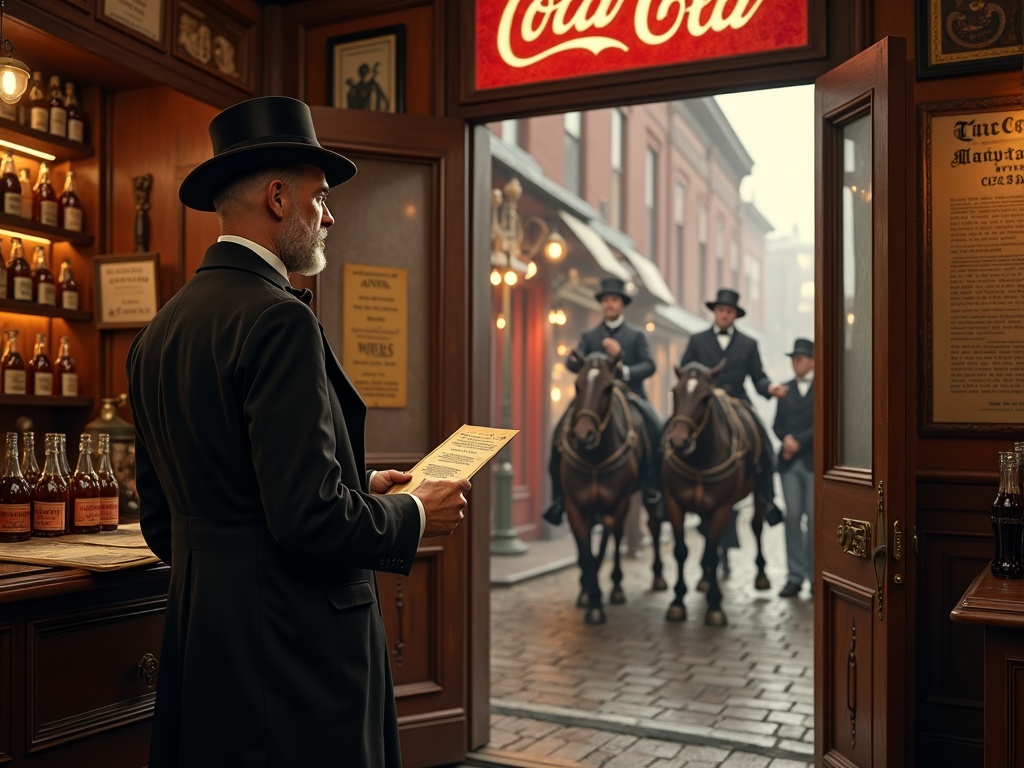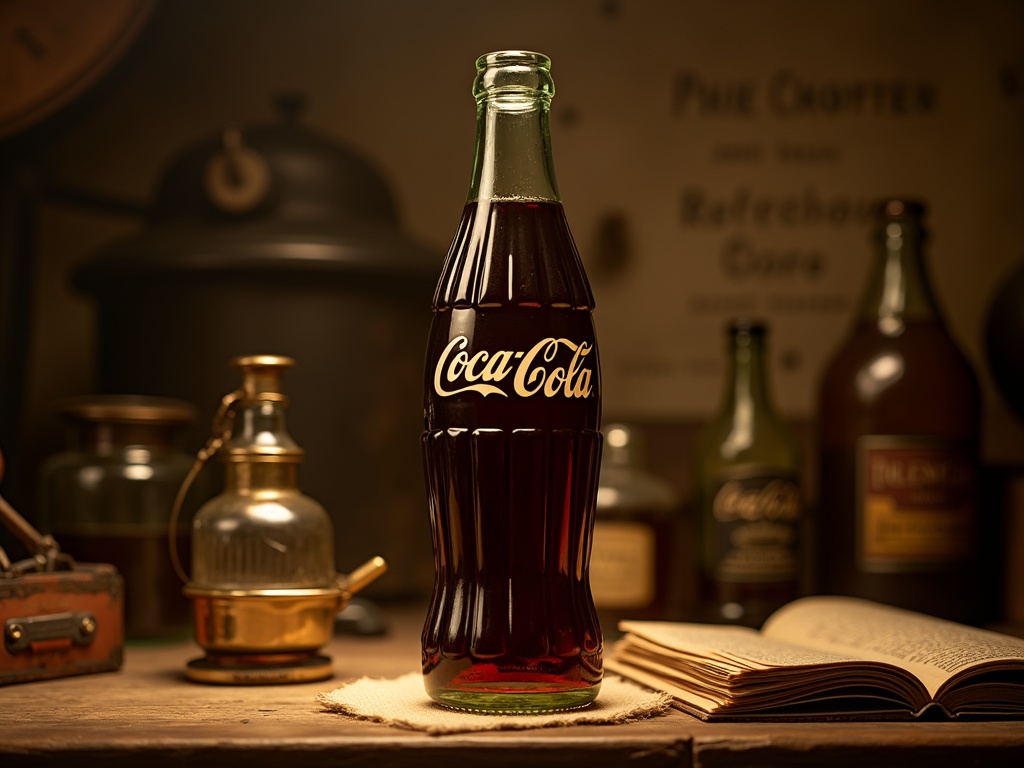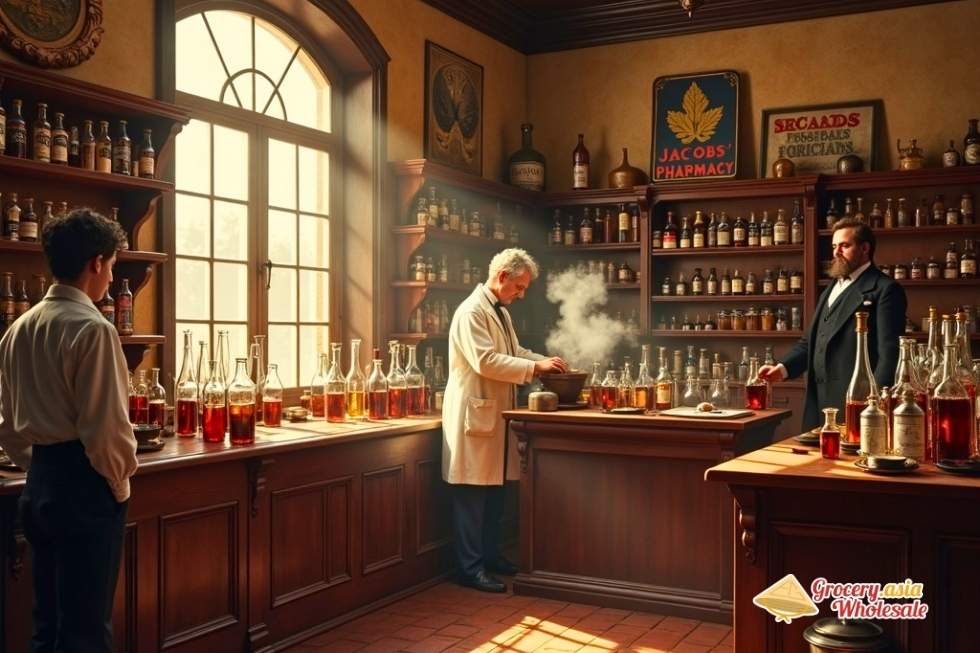No products in the cart.
Beverages News, Coca-Cola Carbonated Soft Drinks, Soft Drinks
When Was Coke Invented And How It Changed Drinks
When was Coke invented is a question that takes us back to May 8, 1886, when Dr. John Stith Pemberton created Coca-Cola in his Atlanta pharmacy. Originally marketed as a medicinal nerve tonic containing cocaine, this invention fundamentally transformed the beverage industry, shifting drinks from simple refreshments to branded lifestyle products. The creation of Coca-Cola also revolutionized how beverages are marketed, distributed, and consumed globally, establishing the template for modern soft drink culture through packaging innovations, advertising campaigns, and franchise bottling systems.
This invention revolutionized how drinks are marketed, distributed, and consumed globally, establishing the template for modern soft drink culture through innovations in packaging, advertising, and franchise bottling systems.
Table of Contents
Key Takeaways
- Coca-Cola originated as a medicinal tonic in 1886 when pharmacist Dr. John Pemberton created it to replace his alcohol-based French Wine Coca, initially containing 9 milligrams of cocaine per glass before reformulation in 1903.
- Asa Candler’s business transformation from 1891-1892 shifted Coca-Cola from medicine to refreshment beverage, pioneering modern promotional marketing with free sample coupons and creating the franchise bottling system for $1 in 1899.
- Revolutionary packaging and branding innovations included the iconic contour bottle design in 1915, the six-pack carrier in 1923, and widespread brand placement that embedded Coca-Cola into American daily life.
- Advertising breakthroughs changed marketing forever through massive investment ($1 million by 1912), creation of the modern Santa Claus image in 1931, and establishing emotional brand connections rather than product-focused messaging.
- Global expansion and competition shaped the industry through World War II military distribution creating 64 overseas plants, the Cola Wars driving product diversification, and the New Coke incident demonstrating the power of consumer brand loyalty.
When Was Coke Invented? The Birth of a Global Icon in 1886
I find it fascinating that one of the world’s most recognizable beverages emerged from a small Atlanta pharmacy on May 8, 1886. Dr. John Stith Pemberton, a pharmacist and Confederate army veteran, created what would become Coca-Cola’s global phenomenon while working in his downtown Atlanta laboratory.
Pemberton originally formulated the drink as a “nerve tonic” and patent medicine, targeting customers who suffered from headaches, fatigue, and various other ailments. This medicinal approach wasn’t unusual for the era, as many pharmacists developed tonics and remedies that promised to cure common health problems. The first glass sold at Jacobs’ Pharmacy for five cents, marking the beginning of what would eventually become Coca-Cola’s global presence.
The Creative Partnership Behind the Name
The distinctive name “Coca-Cola” didn’t come from Pemberton himself but from his bookkeeper, Frank M. Robinson. Robinson not only suggested the memorable name but also designed the iconic Spencerian script logo that remains virtually unchanged today. His artistic contribution proved invaluable, as the flowing script became instantly recognizable and helped establish the brand’s visual identity from its earliest days.
Pemberton developed Coca-Cola as a direct response to Atlanta’s temperance legislation, which had made his previous creation, “Pemberton’s French Wine Coca,” problematic due to its alcohol content. He needed a non-alcoholic alternative that would still appeal to customers seeking medicinal benefits. This practical business decision inadvertently set the stage for creating one of history’s most successful soft drinks.
The original formula contained approximately 9 milligrams of cocaine per glass, derived from coca leaves. During the 1880s, cocaine wasn’t a hidden ingredient but rather a prominent selling point that manufacturers proudly advertised for its supposed medicinal properties. Medical professionals and the general public viewed cocaine as beneficial for treating depression, fatigue, and various aches and pains. Pemberton marketed this ingredient openly, as it aligned with contemporary medical practices and consumer expectations for patent medicines.
Pemberton’s background as both a pharmacist and Civil War veteran influenced his approach to creating medicinal tonics. His experience treating wounded soldiers had exposed him to various pain management techniques and remedies, knowledge he applied when developing commercial products. This medical foundation gave credibility to his claims about Coca-Cola’s therapeutic benefits.
The timing of Coca-Cola’s invention coincided perfectly with America’s growing soda fountain culture. Pharmacies across the country were installing soda fountains, and customers increasingly sought refreshing drinks that offered more than simple refreshment. Pemberton’s creation filled this niche by combining the appeal of a tasty beverage with promised health benefits.
I observe that Pemberton’s original marketing strategy focused heavily on the drink’s medicinal qualities rather than its taste or refreshment value. Early advertisements emphasized Coca-Cola’s ability to cure headaches, relieve exhaustion, and calm nerves. This medicinal positioning differentiated it from other beverages available at soda fountains and justified its five-cent price point.
The drink’s early success at Jacobs’ Pharmacy demonstrated consumer appetite for products that promised both pleasure and health benefits. Customers appreciated having an option that tasted good while supposedly improving their well-being. This dual appeal became fundamental to Coca-Cola’s identity, even as the company later shifted away from medical claims.
Pemberton’s invention occurred during a period of significant innovation in American pharmacology and consumer products. The late 19th century saw numerous pharmacists creating tonics, elixirs, and patent medicines, but few achieved the lasting success of Coca-Cola. The combination of:
- Effective marketing
- Appealing taste
- Strategic ingredient selection
set Pemberton’s creation apart from competitors, eventually leading to the intense rivalry we see today in Coca-Cola and PepsiCo battles.

From Medicine to Business Empire: The Candler Revolution
Asa Griggs Candler saw something extraordinary in Pemberton’s struggling concoction. By 1891, he’d acquired the complete formula and rights from Pemberton’s heirs for approximately $2,300. This purchase marked the beginning of one of the most dramatic business transformations in American history.
Marketing Innovation That Changed Everything
Candler possessed an understanding of consumer psychology that was decades ahead of his time. He pioneered the use of coupons for free samples, a revolutionary tactic that drove widespread trial of the product. These free taste promotions created demand where none existed before, turning curious consumers into loyal customers. This simple strategy laid the foundation for modern promotional marketing.
The official incorporation of The Coca-Cola Company in 1892 formalized Candler’s vision. He systematically shifted the product’s marketing from “medicinal” to “refreshing,” fundamentally changing how consumers perceived the beverage. Rather than positioning it as a cure-all tonic, Candler marketed Coca-Cola as a delicious refreshment that people could enjoy anytime.
The $1 Decision That Built an Empire
Perhaps Candler’s most consequential business decision came in 1899. He sold the exclusive bottling rights for most of the United States to Benjamin Thomas and Joseph Whitehead for just one dollar. This seemingly modest transaction created the franchise bottling system that enabled massive expansion without requiring company capital for bottling infrastructure.
The $1 bottling contract proved to be a masterstroke of strategic thinking. Instead of investing millions in bottling facilities across the country, Candler allowed independent operators to handle distribution while maintaining control over the syrup formula. This model enabled Coca-Cola’s global expansion at an unprecedented pace.
Candler’s genius lay in recognizing that the real value wasn’t in manufacturing bottles or managing distribution networks. The true asset was the secret formula and the brand itself. By franchising bottling operations, he created a network of motivated business partners who had financial incentives to promote and distribute the product effectively.
This transformation from Pemberton’s medicinal syrup to Candler’s refreshment empire established the template for modern beverage marketing. The combination of:
- Innovative promotion,
- Strategic positioning,
- Smart distribution partnerships
turned a struggling pharmacy concoction into America’s most recognizable brand. Candler’s revolution proved that exceptional marketing could transform any product into a cultural phenomenon.

Creating the Brand Identity: The Contour Bottle and Formula Evolution
The Iconic Contour Bottle Design
By 1915, Coca-Cola faced a serious problem with imitators flooding the market with confusingly similar names like “Koka-Nola.” I find it remarkable that the company’s solution involved launching a competition to create a distinctive bottle that would be recognizable even in the dark. The Root Glass Company of Terre Haute, Indiana, emerged victorious with designer Earl R. Dean’s revolutionary design.
Dean’s inspiration came from an unexpected source — he based the bottle’s ribbed shape on a cacao pod, mistakenly believing cacao was an ingredient in Coca-Cola. This happy accident created one of the most recognizable package designs in history. The contour bottle received its patent on November 16, 1915, and became the standard packaging by 1920. This innovative approach to Coca-Cola’s global icon status helped distinguish the authentic product from countless imitators.
Formula Modifications and Legal Pressures
The early 1900s brought significant changes to Coca-Cola’s formula due to mounting social and legal pressures. Around 1903, growing public concern and anti-drug sentiment forced the company to remove cocaine from its recipe. However, maintaining the “Coca” part of the brand name required creative solutions.
Coca-Cola began using “spent” or decocainized coca leaves to preserve both the name’s integrity and the distinctive flavor profile. The Stepan Company in New Jersey became the sole entity legally authorized to import coca leaves for this purpose. This arrangement continues today, demonstrating the company’s commitment to maintaining its original character while adapting to regulatory requirements.
The Pure Food and Drug Act of 1906 intensified pressure on Coca-Cola to eliminate harmful ingredients and provide accurate labeling. These regulatory changes fundamentally altered how the company marketed its product. Advertising strategies shifted away from medicinal claims and embraced purely refreshment-focused messaging.
I notice how this period marked the birth of some of Coca-Cola’s most enduring marketing approaches. Slogans like “Delicious and Refreshing” emerged during this era, establishing the foundation for modern soft drink advertising. The company’s ability to navigate these challenges while maintaining its core identity laid the groundwork for Coca-Cola’s global presence that would follow in subsequent decades.
These formula modifications and branding innovations occurred during a crucial period when consumer protection laws were reshaping the entire food and beverage industry. Coca-Cola’s proactive approach to these changes helped establish it as a leader in both product safety and marketing innovation.

Revolutionizing Advertising: How Coca-Cola Changed Marketing Forever
I’ve witnessed few companies transform marketing as dramatically as Coca-Cola did in its early decades. By 1900, the company’s advertising budget exceeded $100,000 and exploded to over $1 million by 1912. This massive investment created a blueprint for modern brand marketing that companies still follow today.
Pioneering Brand Omnipresence
Coca-Cola revolutionized advertising by placing its logo everywhere Americans looked. The company pioneered brand omnipresence by distributing its imagery across clocks, calendars, serving trays, and countless other everyday items. This strategy went far beyond traditional newspaper advertisements, embedding the brand directly into consumers’ daily routines.
Creating Cultural Icons Through Advertising
Starting in 1931, artist Haddon Sundblom created magazine advertisements featuring a warm, jolly Santa Claus that fundamentally changed Western culture. These Santa images proved instrumental in shaping the modern, widespread image of Santa that we recognize today. Prior to Coca-Cola’s campaign, depictions of Santa Claus varied widely and were sometimes elf-like. Sundblom’s consistent portrayal established the red-suited, white-bearded figure as the definitive Santa Claus across America and beyond.
The company’s advertising strategy focused on integrating the brand into everyday American lifestyle rather than simply promoting a product. Coca-Cola understood that successful marketing required selling more than refreshment—they sold an identity tied to American culture and values. Their advertisements portrayed:
- Moments of happiness
- Family gatherings
- Social connections
This positioned Coca-Cola as an essential component of the American experience.
This approach created emotional connections that transcended the beverage itself. Consumers didn’t just purchase a drink; they bought into a lifestyle and cultural identity that Coca-Cola carefully crafted through decades of strategic advertising. The company’s marketing innovations established templates for brand building that influenced generations of marketers and helped create the modern advertising industry we know today.
Transforming Distribution: How Coca-Cola Changed the Way We Buy Drinks
The introduction of the six-pack bottle carrier in 1923 marked a revolutionary shift in how consumers purchased beverages. I find this innovation particularly significant because it fundamentally changed buying behavior from purchasing single servings to buying in bulk quantities. This simple packaging breakthrough encouraged consumers to take Coca-Cola home rather than consuming it solely at soda fountains, creating an entirely new market dynamic that would reshape the entire beverage industry.
Beyond packaging innovations, the company actively promoted refrigerated vending machines, establishing fresh sales channels that brought convenience directly to consumers. These machines created new opportunities for product sales in locations previously inaccessible to traditional retail methods. The strategic placement of vending machines expanded Coca-Cola’s global presence while making the beverage available around the clock.
Global Expansion Through Military Distribution
During World War II, company president Robert Woodruff made a remarkable commitment that would transform the brand’s international reach. He pledged that every U.S. service member could purchase a Coke for five cents anywhere in the world, regardless of production costs. This ambitious promise led to the establishment of 64 overseas bottling plants during the war years, creating an unprecedented global infrastructure.
The wartime expansion strategy accomplished more than just beverage distribution. It established Coca-Cola as a global icon and symbol of America worldwide. Service members returning home carried memories of the familiar taste, while local populations in various countries experienced their first encounter with the brand.
These distribution innovations created the foundation for the modern beverage market as we know it today. The introduction of take-home packaging, automated vending solutions, and global supply chains established convenience as a core consumer expectation. I observe that these changes didn’t just benefit Coca-Cola; they transformed how all beverage companies approach distribution and marketing.
The company’s distribution strategies demonstrated how packaging innovation could drive consumer behavior changes. By making it easier for people to purchase multiple servings at once, the six-pack carrier increased per-transaction revenue while building brand loyalty through repeat home consumption. Meanwhile, the global expansion during wartime created lasting international partnerships and brand recognition that continue to drive Coca-Cola’s soft drink dominance across diverse markets today.
The Cola Wars and Cultural Impact: How Competition Shaped the Industry
The rivalry between two beverage giants fundamentally transformed the soft drink industry and created one of business history’s most compelling competitive narratives. I’ve witnessed how this competition pushed both companies to innovate constantly and expand their product offerings far beyond their original formulations.
The Birth of the Cola Wars
The “Cola Wars” gained serious momentum in the 1970s when Pepsi launched the revolutionary “Pepsi Challenge” in 1975. This bold blind taste test campaign claimed that more consumers preferred the taste of Pepsi over Coca-Cola, directly challenging the market leader’s supremacy. The marketing strategy proved brilliant, forcing Coca-Cola’s global icon status to defend itself against a younger, more aggressive competitor.
Pepsi’s challenge created such pressure that Coca-Cola made one of the most controversial decisions in corporate history. On April 23, 1985, the company introduced “New Coke,” altering its original formula after 99 years of consistency. This dramatic change represented more than just a recipe adjustment – it challenged the very identity that millions of consumers had embraced for nearly a century.
The public backlash was swift and intense, with consumers expressing genuine outrage at the loss of their beloved beverage. I find it remarkable that a soft drink could generate such passionate responses, but this reaction demonstrated the deep emotional connection people had formed with the brand. Just 79 days later, Coca-Cola bowed to public pressure and brought back the original formula as “Coca-Cola Classic.”
Innovation Through Competition
The New Coke incident became a textbook case on brand loyalty and customer connection, teaching businesses valuable lessons about respecting consumer attachments. However, the competition between these industry titans didn’t end there – it actually accelerated product diversification across the entire market.
Product diversification increased dramatically during this period, fundamentally changing how consumers approached soft drink choices:
- Diet Coke launched in 1982, capturing the growing health-conscious market segment.
- Cherry Coke followed in 1985, appealing to consumers who wanted flavor variety.
- Coke Zero arrived in 2005, targeting male consumers who wanted zero calories without the “diet” label stigma.
Each product launch represented a strategic response to the competition between Coca-Cola and PepsiCo, forcing both companies to constantly innovate and find new market niches. This competitive pressure ultimately benefited consumers by providing more choices and pushing quality improvements across the industry.
The Cola Wars expanded the overall soft drink market rather than simply dividing existing sales between two competitors. Both companies invested heavily in marketing, distribution, and product development, creating a larger, more sophisticated beverage industry. This expansion introduced consumers to a greater variety of beverage options and established the framework for today’s diverse soft drink marketplace.
I observe that Coca-Cola and PepsiCo continue to influence each other’s strategies, from sustainable development commitments to new product launches. Their rivalry has evolved beyond simple taste preferences to encompass social responsibility, health consciousness, and global market expansion.
Coca-Cola’s transformation from a medicinal tonic invented by Dr. John Pemberton in 1886 to a globally recognized brand illustrates the powerful influence a single product can have on an entire industry. The company’s journey through the Cola Wars demonstrates how competition can strengthen rather than weaken market leaders, provided they remain responsive to consumer needs while maintaining their core identity. Today’s Coca-Cola soft drink continues to benefit from lessons learned during these intense competitive battles, maintaining its position while adapting to changing consumer preferences and market conditions.
https://www.youtube.com/watch?v=7Vq0P4ZqFNI
Sources:
The Coca-Cola Company, “The History of Coca-Cola”
History.com, “The History of Coca-Cola”
Snopes.com, “Cocaine in Coca-Cola”
Mark Pendergrast, “For God, Country, and Coca-Cola: The Definitive History of the Great American Soft Drink and the Company That Makes It”
National Archives, “The Pure Food and Drug Act”


